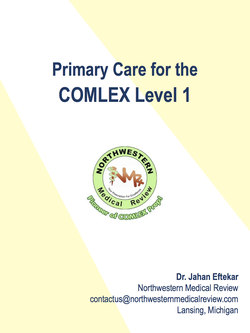Читать книгу Primary Care for COMLEX Level 1 - Dr. Jahan Eftekar - Страница 44
На сайте Литреса книга снята с продажи.
ANATOMY
Оглавление•All GI tract organs have a submucosal layer EXCEPT Gallbladder
•All CNS innervation is contralateral Except for the Cerebellum
•Motor nerves cross contralaterally EXCEPT in the upper half of the face (Forehead is bilateral).
•All postganglionic sympathetics are adrenergic EXCEPT those to the sweat glands (which are cholinergic).
•All Postganglionic sympathetic cells are neurons and release nor-epinephrine onto the effector organs, EXCEPT adrenal medulla that is analogous to a post-ganglionic cell (but releases epinephrine into blood).
•Adrenal is the only gland with direct sympathetic innervation.
•All sympathetic pathways use two nerves--pre and Postganglionic EXCEPT the pathway involved in Horner’s syndrome that uses three neurons.
•Esophagus DOES NOT have a serosa.
•Posterior cricoarytenoid is the only muscle that opens glottis
•All muscles of the tongue (---glossus muscles) are supplied by hypoglossal nerve EXCEPT for the palatoglossus (innervated by vagus, CN X).
•Vagus is the only nerve that wires laryngeal muscles
•All intrinsic muscles of larynx are supplied with recurrent laryngeal nerve EXCEPT cricothyroid.
•All muscles of the perineum attach to a bone EXCEPT the bulbospongiosus (bulbocavernosus).
•All muscle connecting scapula to humerus are in the shoulder area EXCEPT coracobrachialis which is mainly in the arm
•All clinical features of spinal cord hemisection (paralysis of movement, hyperreflexia, spasticity, loss of vibration, weakness, atrophy, loss of sweating, etc.) are ipsilateral and caudal to the level of lesion EXCEPT loss of pain and temperature sensation that are contralateral. EXPLANATION: Interruption of spinothalamic tract causes contralateral effects, while that of lateral corticospinal, dorsal columns, ventral motoneurons, dorsal rootlets, and descending autonomic fibers in ventral column cause ipsilateral effects.
•EXCEPT portal circulation, all circulations start with arteries, capillaries and veins.
•Pulmonary vein contains oxygenated blood.
•All cranial nerves exit the ventral aspect of the brain stem EXCEPT trochlear (CN IV) that exits on dorsal aspect [also it is the longest nerve.]
•All cervical vertebrae has a body EXCEPT Atlas
•Iliac crest is the only part of sacrum with no muscle on tendon on top of it
•Anterior spinal artery supplies all areas of spinal cord EXCEPT dorsal column.
•Femoral nerve DOES NOT travel through the femoral sheath.
•Brunner's alkaline glands of the duodenum are the ONLY GI submucosal glands.
•The posterior white columns of spinal cord have the lower limb topographically on the medial side, but it is lateral in all other tracts.
•Trapezius is the ONLY back muscle that is innervated by a cranial nerve.
•All muscles that move the head are attached to vertebra EXCEPT Sternocleidomastoid.
•Olfactory nerve endings directly terminate in the mucosa
•All eye nerves go into the orbit through superior orbital fissure EXCEPT optic nerve that uses optic canal
•All eye-related nerves—CN 3, 4, 5, 6 plus sympathetics--enter the orbit through the superior orbital fissure EXCEPT optic nerve (CN 2) that enters via optic canal.
•Lateral pterygoid is the only muscle of mastication that lowers the jaw--all others--Medial Pterygoid, Masseter. and Temporals, raise the jaw.
•All spinal nerves run under their respective vertebrae EXCEPT cervical nerves that run above their related vertebrae.
•All spinal nerves have related vertebrae EXCEPT nerve C8 that has none.
•Of the two overlapping and parallel muscles of the body, the shorter one always run deeper EXCEPT in case of Flexor Digitorum profundus that the longer one is located deeper.
